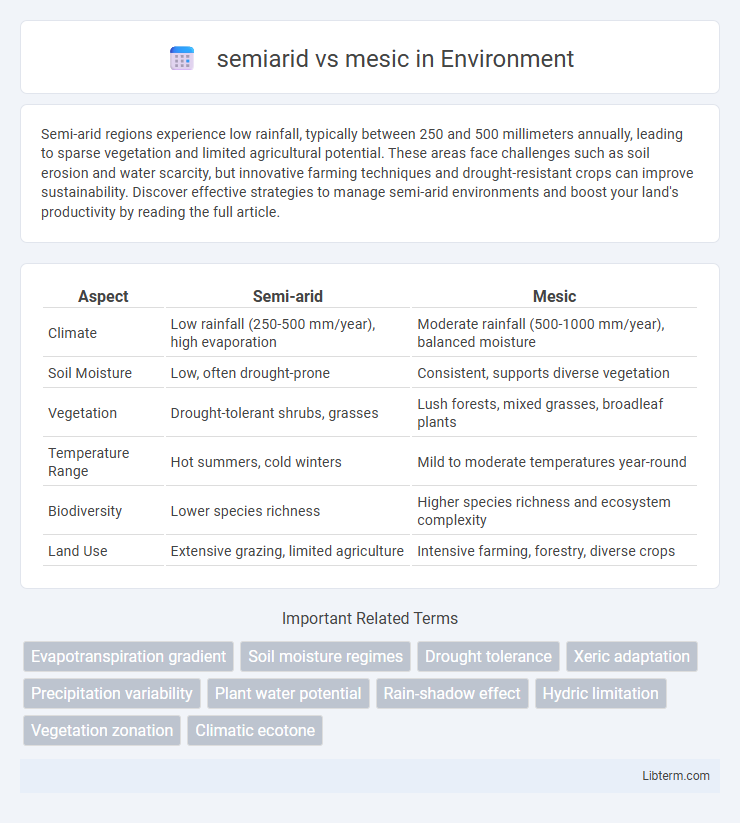Semi-arid regions experience low rainfall, typically between 250 and 500 millimeters annually, leading to sparse vegetation and limited agricultural potential. These areas face challenges such as soil erosion and water scarcity, but innovative farming techniques and drought-resistant crops can improve sustainability. Discover effective strategies to manage semi-arid environments and boost your land's productivity by reading the full article.
Table of Comparison
| Aspect | Semi-arid | Mesic |
|---|---|---|
| Climate | Low rainfall (250-500 mm/year), high evaporation | Moderate rainfall (500-1000 mm/year), balanced moisture |
| Soil Moisture | Low, often drought-prone | Consistent, supports diverse vegetation |
| Vegetation | Drought-tolerant shrubs, grasses | Lush forests, mixed grasses, broadleaf plants |
| Temperature Range | Hot summers, cold winters | Mild to moderate temperatures year-round |
| Biodiversity | Lower species richness | Higher species richness and ecosystem complexity |
| Land Use | Extensive grazing, limited agriculture | Intensive farming, forestry, diverse crops |
Introduction to Semiarid and Mesic Environments
Semiarid environments typically receive between 250 to 500 millimeters of annual precipitation, resulting in sparse vegetation adapted to drought conditions. Mesic environments have moderate moisture levels, with annual precipitation ranging from 500 to 1000 millimeters, supporting diverse plant communities and more robust ecosystems. Soil moisture and climate variations distinctly influence biodiversity and land use in both semiarid and mesic regions.
Defining Semiarid Regions: Key Characteristics
Semiarid regions are characterized by low annual precipitation ranging from approximately 250 to 500 millimeters, resulting in sparse vegetation and frequent drought conditions. Soil in these areas often exhibits reduced organic matter due to limited moisture, impacting land use and agricultural productivity. Unlike mesic regions, which receive moderate rainfall supporting diverse plant life and robust ecosystems, semiarid zones experience higher evapotranspiration rates, creating a distinct climate that influences water availability and habitat sustainability.
Understanding Mesic Zones: Essential Features
Mesic zones are characterized by moderate moisture levels, supporting diverse plant and animal species adapted to stable water availability. These environments contrast with semiarid regions, which experience lower precipitation and more frequent drought conditions, limiting biodiversity and vegetation density. Understanding mesic zones involves recognizing their critical role in maintaining ecological balance and supporting fertile soils conducive to agriculture and natural ecosystems.
Climate Patterns in Semiarid vs Mesic Areas
Semiarid regions experience low annual precipitation, typically between 250 to 500 millimeters, resulting in sparse vegetation and frequent drought conditions. Mesic areas receive moderate to high precipitation, generally ranging from 500 to 1500 millimeters annually, supporting dense forests and diverse ecosystems. Temperature fluctuations in semiarid climates are more extreme, with hotter summers and colder winters, whereas mesic climates maintain more stable and moderate temperatures year-round.
Soil Composition and Water Availability
Semiarid regions feature soil with low organic matter and higher mineral content, resulting in poor water retention and limited nutrient availability, while mesic soils are richer in organic material and exhibit better moisture-holding capacity, supporting diverse plant growth. Water availability in semiarid areas is often sporadic and insufficient for sustaining high biomass, whereas mesic environments maintain consistent soil moisture levels, enabling more stable ecosystems. The contrast in soil composition and water dynamics fundamentally influences vegetation density and agricultural potential between semiarid and mesic zones.
Vegetation Types: Adaptations in Semiarid vs Mesic Ecosystems
Vegetation in semiarid ecosystems primarily features drought-resistant species such as xerophytes, which have adaptations like deep root systems, reduced leaf surfaces, and water-storing tissues to survive limited moisture. In mesic ecosystems, plants tend to be broadleaf deciduous or lush evergreens with extensive foliage, thriving in consistent, moderate water availability. These differences highlight how plant morphology and physiology are tailored to water availability, with semiarid flora focusing on water conservation and mesic flora on maximizing photosynthesis.
Biodiversity and Wildlife Differences
Semiarid ecosystems support specialized biodiversity adapted to limited water availability, including drought-resistant plants, reptiles, and small mammals, resulting in lower species richness compared to mesic environments. Mesic habitats feature higher moisture levels, fostering diverse plant communities such as broadleaf trees and dense understory vegetation that support a wider array of wildlife, including amphibians, birds, and large mammals. The increased water availability in mesic areas promotes complex food webs and habitat heterogeneity, which are critical for sustaining greater biodiversity and ecosystem resilience.
Human Activities and Land Use Practices
Human activities in semiarid regions often involve extensive irrigation and drought-resistant agriculture to combat limited water availability, while mesic areas support more intensive farming and diverse crop cultivation due to higher and more reliable rainfall. Land use practices in semiarid zones frequently include grazing and conservation efforts to prevent soil erosion and desertification, contrasting with mesic regions where deforestation and urban expansion are more common due to favorable growing conditions. Sustainable management in semiarid areas emphasizes water conservation and drought mitigation, whereas mesic environments prioritize balancing development with preserving biodiversity and ecosystem services.
Challenges and Environmental Concerns
Semiarid regions face significant water scarcity challenges due to low and erratic precipitation, leading to soil degradation and desertification risks that threaten agricultural sustainability and biodiversity. Mesic environments, characterized by moderate moisture, encounter issues such as nutrient leaching and increased vulnerability to invasive species, which can disrupt native ecosystems and reduce soil fertility. Both ecosystems demand tailored land management practices to mitigate environmental concerns while supporting resilient vegetation and wildlife habitats.
Conservation Strategies for Semiarid and Mesic Landscapes
Conservation strategies for semiarid landscapes emphasize water retention techniques, drought-resistant native plant restoration, and soil erosion control to sustain fragile ecosystems. Mesic landscapes prioritize maintaining biodiversity through habitat connectivity, invasive species management, and water quality protection to support moisture-rich environments. Both approaches integrate adaptive management practices tailored to local climate variability and ecological conditions for long-term ecosystem resilience.
semiarid Infographic

 libterm.com
libterm.com